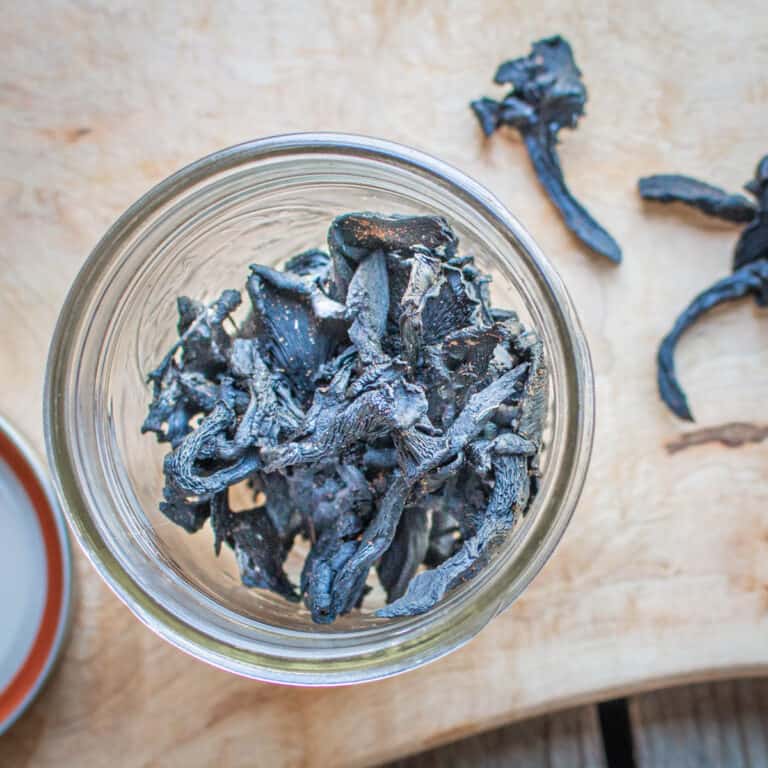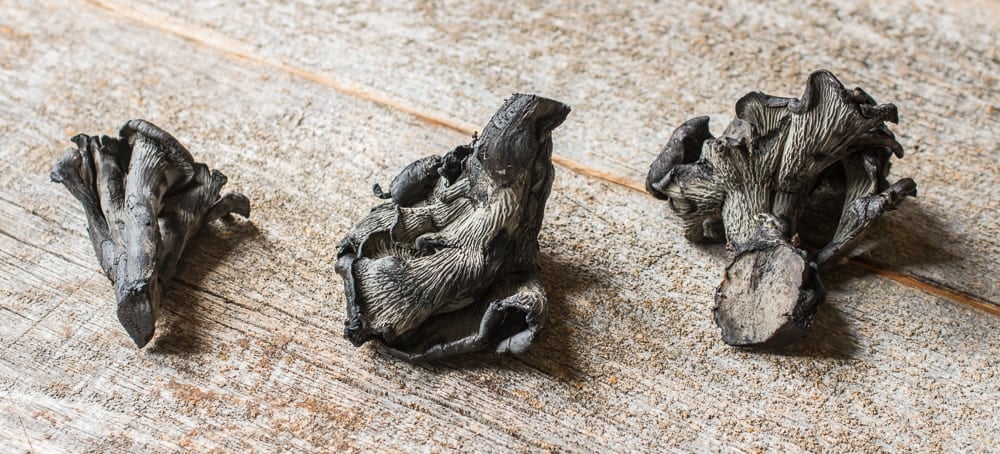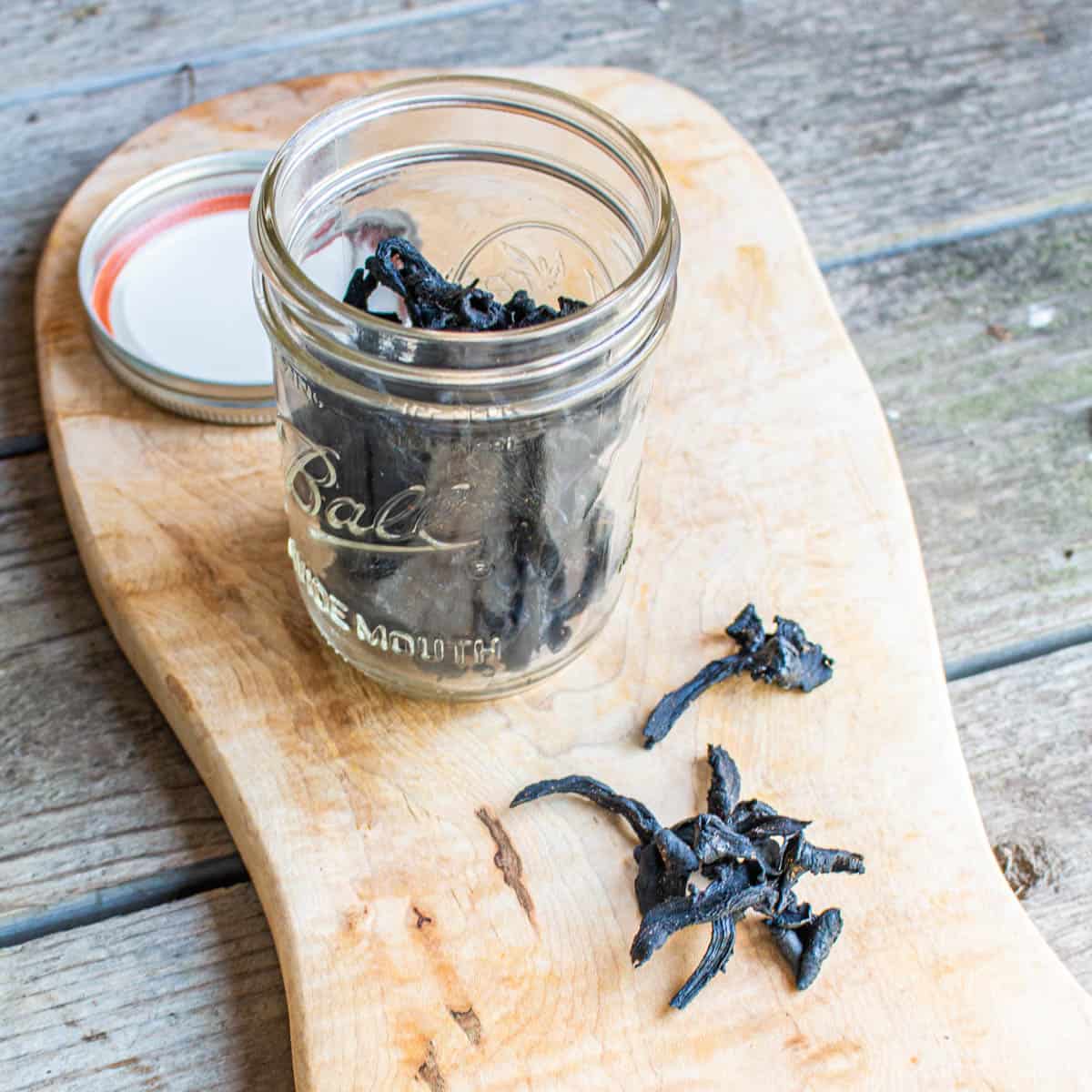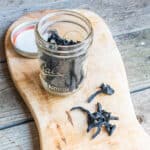Blue chanterelles are one of the all-time best wild mushrooms for jerky. Read on and I'll explain why.

When I started pulling apart clusters of blue chanterelles / Polyozellus multiplex in my kitchen, just handling them told me one of the first things to do. These are fascinating mushrooms, with a scent that's almost smoky, and a texture that's tender and soft. I thought they could make even better jerky than hen of the woods with their texture. They do.

If you haven't made mushroom jerky, it's a good snack, and plenty of people would be hard-pressed to know the difference between these and meat. Here's a simple recipe.

Blue Chanterelle Jerky
Mushroom jerky made from Polyozellus multiplex--the blue clustering chanterelle
Servings: 6 Servings
Calories: 184kcal
Equipment
- 1 Dehydrator
- 1 large mixing bowl
Ingredients
- 1-2 lbs Blue chanterelles or other mushrooms pulled apart into individual leaves or clusters
- 1 ½ cups soy sauce
- 1 ½ cups worchesterchire
- ½ cup water
- ½ cup maple syrup
- 1 Tablespoon hot sauce or more to taste
- 2 Tablespoons finely chopped fresh garlic
- 1 Tablespoon finely chopped fresh ginger
- 1 Tablespoon onion powder
- 1 Tablespoon smoked paprika
Instructions
- Combine the liquid and dry ingredients for the marinade and puree in a blender, then strain.
- Working in batches if needed, blanch the blue chanterelles for 5 minutes in boiling water to cover, then drain well. Strain the cooking water to remove impurities, cool and reserve for another purpose, like making soup.
- If you’re the kind of person that forgets about things in the fridge, season the mushroom cooking liquid with a good pinch of salt to taste to extend the shelf life.
- Combine the blanched mushrooms with the marinade and soak for 24 hours, then drain well in a colander, patting dry with paper towels if needed.
- Dry the mushrooms at around 100 F, or until completely dried, but still pliable, this should take about 5-6 hours, but dehydrators can vary a bit.
- Taste them a few times during the process if it's your first time to get a sense of how the texture changes.
Notes
Scaling the recipe
This recipe will cure about 2 lbs of mushrooms at a time, and can be re-used for multiple batches. It’s very important not to dry the mushrooms at too high of a temperature, which can make them brittle, blood-drawing splinters, as opposed to pliable, chewy jerky.Over-drying
Over-drying can ruin mushroom jerky. If the mushrooms become brittle, you dried them at too hot of a temperature.Nutrition
Serving: 1oz | Calories: 184kcal | Carbohydrates: 39g | Protein: 9g | Fat: 0.5g | Saturated Fat: 0.1g | Polyunsaturated Fat: 0.2g | Monounsaturated Fat: 0.03g | Sodium: 78mg | Potassium: 1012mg | Fiber: 2g | Sugar: 26g | Vitamin A: 629IU | Vitamin C: 11mg | Calcium: 124mg | Iron: 6mg


LAURA A DEKEYREL
Can you speak to the safe shelf life of mushroom jerky made without preservatives I'm also wondering as these are left softer than the "cracker dry" state that we usually dry mushrooms to? I am using Hen and wondering if you have frozen your jerky and what this does to the texture. Love all your posts and recipes!!
Alan Bergo
Hey Laura. Well, I'd say salt is a preservative. The fact that they're not dried on high heat is why they're not cracker dry, and it's a moot point re: shelf stability here. Polyozellus multiplex is just naturally softer than hens, too, their texture is a bit different. That being said, you can sub hens here, and I've been meaning to just put a version up for hens as they're a great substitute, and far more accessible than P. multiplex. Happy hunting.